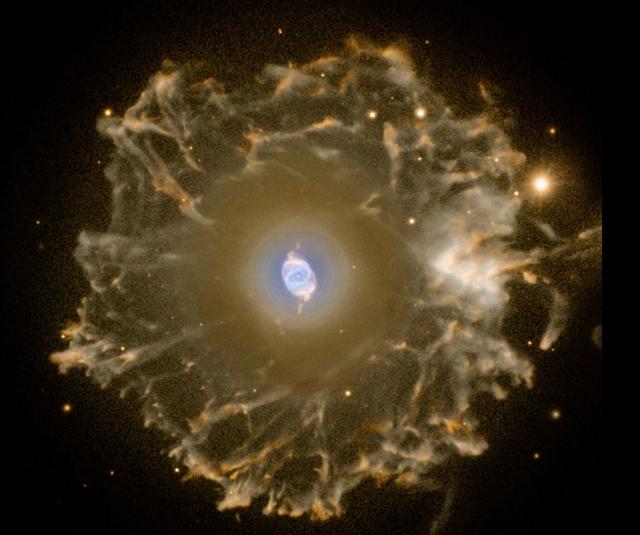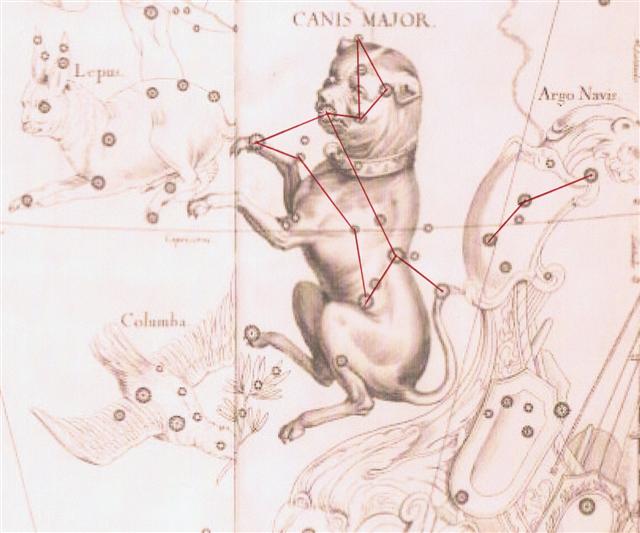Counting the distance from Sirius (181) to Nunki
(*288) - both stars connected with water ahead - we could easily arrive
at the key number 107.
The day number for APRIL 17 (107) + the day number for Sirius in
JUNE 30 (181) = 288 (OCTOBER 15) and. Nunki rose with the Sun in
OCTOBER 31 (304), 16 days later - i.e. in day 304 + 64 = 368
(January 3) = right ascension day *288. 16 + 64 = 80 = 368 - 288.
This confusing number play is
not arbitrary, because at the time when heliacal Sheratan was at
0h (in Roman times) Nunki would have been at right ascension day *288 -
*27 = *261,
which number 'happens to be' equal to 181 + 80 (=
9 * 29).
I.e. 107 = 80 + 27. By combining the effects of the precession
with the position of Sirius order can be found.
Furthermore, the minimum number of nights before a star
reappeared again after having risen together with the blinding Sun was
16.

At some time in the past the method for determining
number of nights counted from a star being at the Sun could have changed
from a definition based on when the star would return to visibility
again to a definition based on its true heliacal position. Such a change would have
increased the effects of the precession with 16 (= 80 - 64)
days, pushing the star positions in the past ahead
in the year further (more).
The heliacal position of for instance Betelgeuze
would according to such an old method not have been in June 17
(*88) but in July 3 (184) - where Adara (ε Canis Majoris, at the
belly of the Great Dog) rose heliacally according to the
modern method. Notably the 'moist one', Ardra, is a quite
similar sounding name:
|
ORION: |
|
5 |
Mrigashīrsha |
λ, φ¹, and φ² Orionis |
Stag's head |
83 = 68
+ 15 |
|
the deer's head |
Heka |
June 12 (163) |
|
6 |
Ardra |
α Orionis |
Teardrop, diamond, a human head |
88 = 83
+ 5 |
|
the moist one |
Betelgeuze |
June 17 (168) |
 |
 |
 |
 |
 |
|
Ga1-22 |
Ga1-23 |
Ga1-24 |
Ga1-25 |
Ga1-26 |
|
APRIL 12 |
13 |
14 (104) |
15 |
16 |
|
μ Columbae, Saiph (86.5), τ
Aurigae, ζ Leporis (86.6) |
υ Aurigae (87.1), ν Aurigae (87.2),
Wezn, δ Leporis (87.7), Tze (87.9) |
Ardra-6
ANA-VARU (8) |
η Leporis (89.0),
PRAJA-PĀTI,
MENKALINAN, MAHASHIM,
and
γ COLUMBAE
(89.3), π Aurigae (89.4), η Columbae
(89.7) |
μ Orionis (90.3), χ² Orionis (90.5) |
|
χ¹ Orionis, ξ Aurigae (88.1),
BETELGEUZE
(88.3), ξ Columbae (88.5), σ
Columbae (88.7)
ZUBEN
ELGENUBI
|
|
June
15 |
16 |
17 (168) |
18 |
19 |
|
June 11 |
12 |
13 (164) |
14 |
15 |
|
NAKSHATRA DATES: |
|
OCTOBER 12 |
13 |
14 |
15 (288) |
16 |
|
Muliphen (269.0), Basanismus
(269.5), Pherkard (269.9) |
Ptolemy Cluster
(270.5),
Grumium (270.9) |
Rukbalgethi Genubi (271.1), ξ
Herculis (271.5), Etamin, ν Herculis
(271.7), ν Ophiuchi (271.8) |
Cat's Eye
(270.2), ζ Serpentis (272.4), τ
Ophiuchi (272.9) |
Winnowing Basket-7 |
|
18h (273.4) |
|
NASH
(273.7), θ Arae (273.8) |
|
December
15 |
16 (350) |
17 |
18 |
19 |
|
December
11 |
12 (346) |
13 |
14 |
15 |


|
APRIL 17 (107) |
18 |
19 |
20 (*30) |
21 |
 |
 |
 |
 |
 |
|
Ga1-27 |
Ga1-28 |
Ga1-29 |
Ga1-30 |
Ga2-1 |
|
6h (91.3) |
ξ Orionis (92.5) |
Al Han'ah-4 /
Maru-sha-pu-u-mash-mashu-7 |
Furud (94.9) |
Well-22 /
Arkū-sha-pu-u-mash-mashu-8 |
|
ν Orionis (91.4), θ Columbae (91.5),
π Columbae (91.6) |
TEJAT PRIOR
(93.4), γ Monocerotis (93.5), κ
Aurigae (93.6), κ Columbae (93.8) |
δ Columbae (95.2),
TEJAT POSTERIOR,
Mirzam (95.4),
CANOPUS
(95.6), ε Monocerotis (95.7), ψ1
Aurigae (95.9) |
|
SOLSTICE |
June 23 (174) |
ST JOHN'S EVE |
|
'May 24 (*64) |
25 |
26 |
27 |
28 (*68) |
|
NAKSHATRA DATES: |
|
OCTOBER 17 (290) |
18 |
19 |
20 |
21 (*214) |
|
Zhōngshān (274.0), π Pavonis (274.6) |
ι
Pavonis (275.1),
Polis
(275.9)
MENKAR
|
η Sagittarii
(276.9) |
Purva Ashadha-20 |
|
KAUS MEDIUS,
κ Lyrae (277.5), Tung Hae (277.7),
Shaou Pih (277.8), Kwei She (277.9) |
φ Oct.
(278.1),
KAUS AUSTRALIS
(278.3), ξ Pavonis (278.4),
Al Athfar (278.6) |
|
SOLSTICE |
December 23 (357) |
CHRISTMAS EVE |
|
'November 23
(327) |
24 |
25 |
26 |
27 (*251) |
|
APRIL 22 |
23 |
24 |
25 (*35) |
26 |
27 |
(118 = 4 * 29½) |
 |
 |
 |
 |
 |
 |
 |
|
Ga2-2 |
Ga2-3 |
Ga2-4 |
Ga2-5 (35) |
Ga2-6 |
Ga2-7 |
Ga2-8 |
|
no star listed (96) |
β Monocerotis, ν Gemini (97.0) |
no star listed (98) |
ν Puppis (99.2), ψ3 Aurigae (99.4),
ψ2 Aurigae (99.5)
GEMMA
|
ψ4 Aurigae (100.5), Mebsuta (100.7) |
SIRIUS
(101.2), ψ5 Aurigae (101.4), ν
Gemini (101.6), ψ6 Aurigae (101.7) |
τ PUPPIS
(102.2), ψ7 Aurigae (102.4) |
|
June 25 |
26 (6 * 29½) |
27 |
28 |
29 (180) |
30 |
July 1 |
|
SOLSTICE (172) |
June 22 |
23 |
ST JOHN'S EVE |
25 |
26 |
27 |
|
NAKSHATRA DATES: |
|
OCTOBER 22 |
23 |
24 |
25
(*218) |
26 |
27 (300) |
28 |
|
Kaus
Borealis (279.3) |
ν
Pavonis (280.4), κ Cor. Austr.
(280.9) |
Abhijit-22 |
no
star listed (282) |
ζ
Pavonis (283.4), λ Cor. Austr.
(283.6),
Double Double (283.7),
ζ Lyrae
(283.8) |
South Dipper-8 |
Sheliak, ν Lyrae (285.1), ο Draconis
(285.5). λ Pavonis (285.7)
ATLAS |
|
θ Cor.
Austr. (281.0),
VEGA
(281.8) |
Φ SAGITTARII
(284.0), μ Cor. Austr. (284.6), η
Cor. Austr., θ Pavonis (284.8) |
|
December
25 |
26 |
27 |
28 |
29 |
30 (364) |
31 |
|
SOLSTICE (*275) |
December 22 |
23 |
CHRISTMAS EVE |
25 |
26 (360) |
27 |
|
APRIL 29 |
30 |
MAY 1 (*41) |
2 (122) |
 |
 |
 |
 |
|
Ga2-9 |
Ga2-10 |
Ga2-11 |
Ga2-12 (42) |
|
Mash-mashu-sha-Risū-9 |
ADARA
(104.8) |
ω Gemini (105.4),
Alzirr
(105.7), Muliphein (105.8), Mekbuda
(105.9) |
7h (106.5) |
|
θ Gemini (103.0), ψ8 Aurigae
(103.2),
ALHENA
(103.8), ψ9 Aurigae (103.9) |
no star listed (106) |
|
July 2 |
(*104 = 8 * 13) |
4 (185) |
5 |
|
June 28 |
29 (*100) |
SIRIUS |
July
1 (182) |
|
NAKSHATRA DATES: |
|
OCTOBER 29 |
30 (303) |
31 (*224) |
NOVEMBER 1 |
|
χ
Oct. (286.0),
AIN AL RAMI
(286.2), υ Draconis (286.4), δ Lyrae
(286.3), κ Pavonis (286.5), Alya
(286.6) |
ξ
Sagittarii (287.1), ω Pavonis
(287.3), ε Aquilae, ε Cor. Austr.,
Sulaphat (287.4), λ Lyrae (287.7),
Ascella,
Bered (Ant.) (287.9) |
Al Na'ām-18 /
Uttara Ashadha-21 |
19h (289.2) |
|
NUNKI
(288.4), ζ Cor. Austr. (288.5),
Manubrium (288.8), ζ Aquilae (288.9) |
λ
Aquilae (Ant.) (289.1), γ Cor. Austr
(289.3), τ
Sagittarii (289.4), ι Lyrae
(289.5), δ Cor. Austr. (289.8)
|
|
January 1 |
2 |
3 (368) |
4 |
|
December
28 |
29 |
(14 * 26) |
31 (*285) |

472 (the number of day
positions in the G text) - 107 = 365. In addition to explaining
the 4 day difference between the stars at the time of Gregory
XIII and the positions of the stars in rongorongo times, the
creator of the G tablet clearly could have had the intention to educate the readers about the
precessional difference between the time of Julius Caesar (with
the First Point of Aries at 0h) and
rongorongo times (with Sirrah at 0h). 472 = 8 * 59 = 365 + 107.
The pair of dark mama
sea shells at nakshatra τ (Kerb) and υ Pegasi came 68 days after
heliacal
τ Puppis in APRIL 28 (118 = 472 / 4),
which in rongorongo times was 68 nights after July 1. 182 + 68 =
250 (September 7). Kerb was close to the Full Moon in day 250 (September
7) + 183 - 365 = 68 (March 9):
|
63 |
 |
 |
 |
 |
 |
|
Ga4-23 |
Ga4-24 |
Ga4-25 (108) |
Ga4-26 |
Ga4-27 |
|
JULY 5 |
6 (*107) |
7 |
8 |
9 (190) |
|
JULY 1 |
2 |
3 (*104) |
4 (185) |
5 |
|
φ Leonis
(170.0), Alula (170.5), Labrum (170.6) |
σ Leonis
(171.1), λ Crateris (171.6), ι Leonis, ε Crateris
(171.9) |
γ Crateris,
π Centauri (172.0), κ Crateris (172.5), τ Leonis (172.8)
GREDI |
ο¹ Centauri
(173.8) |
GIAUZAR
(174.0), ξ Hydrae (174.3), ο² Centauri, λ Centauri
(174.8) |
|
September 7
(250) |
8 |
9 |
10 |
11 |
|
September 3 |
4 |
5 (*168) |
6 |
7 (250) |
|
NAKSHATRA
DATES: |
|
JANUARY 4 |
5 (*290) |
6 |
7 |
8 (373) |
|
DECEMBER 31 |
JANUARY 1 |
2 |
3 (368) |
4 |
|
CROSS-BARS |
ο Gruis,
Snowball
Nebula
(355.0), τ Oct. (355.3) |
no star listed (356) |
ι Phoenicis (357.3), ι
Piscium (357.4),
λ ANDROMEDAE
(357.9) |
|
ο Cephei (353.3),
KERB
(353.6) |
κ Piscium (354.2), θ Piscium
(354.4),
υ PEGASI (354.9) |
|
March 9 (68) |
10 |
11 |
12 |
13 |
|
March 5 (64) |
6
(*350) |
7 |
8 |
9 |
Although according to the Gregorian calendar the
corresponding period would have stretched from December 31 (Ga2-12) to Ga4-23
(March 5), where Kerb would have been close to the Full Moon in
night 64
instead of in night 68. From Ain (at the time of rongorongo) to
Aldebaran (at the time of Gregory XIII) there were 4
precessional days.
Maybe the glyphs were here illustrating the dates
extrapolated backwards in time from the Gregorian calendar (i.e.
as measured from Aldebaran at 0h)
rather than the dates extrapolated from the stars at the time of rongorongo
(i.e. as measured from Ain at 0h).
The heliacal Cross-bars would then have stretched from the end of the
previous year (DECEMBER 31) to the beginning of the new year
(JANUARY 1). Possibly, therefore, the inside markings of the
black chiton (mama) meant 6 + 6 = 12 months in the past.

... Midsummer is
the flowering season of the oak, which is the tree of endurance
and triumph, and like the ash is said to 'court the lightning
flash'. Its roots are believed to extend as deep underground as
its branches rise in the air - Virgil mentions this - which
makes it emblematic of a god whose law runs both in Heaven and
in the Underworld ... The month, which takes its name from
Juppiter the oak-god, begins on June 10th and ends of July 7th.
Midway comes St. John's Day, June 24th, the day on which the
oak-king was sacrificially burned alive. The Celtic year was
divided into two halves with the second half beginning in July,
apparently after a seven-day wake, or funeral feast, in the
oak-king's honour ...

I think these twice 6 months in the past were probably,
however, primarily referring to the situation at the beginning of
JULY.
|















